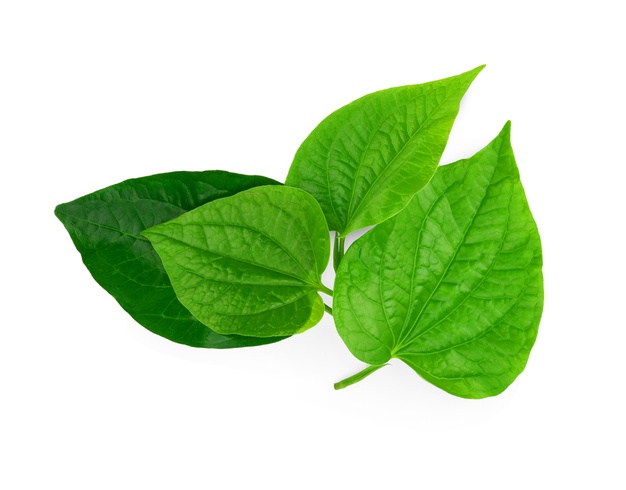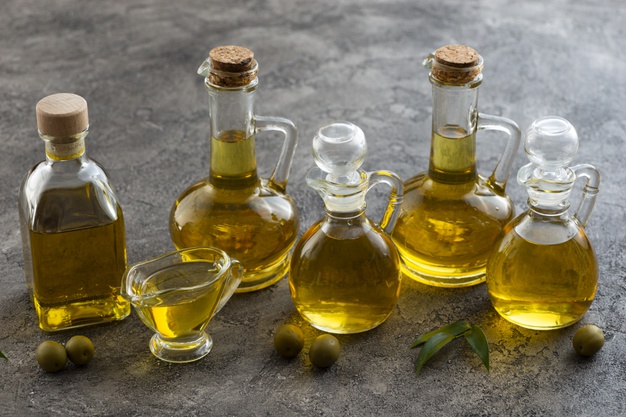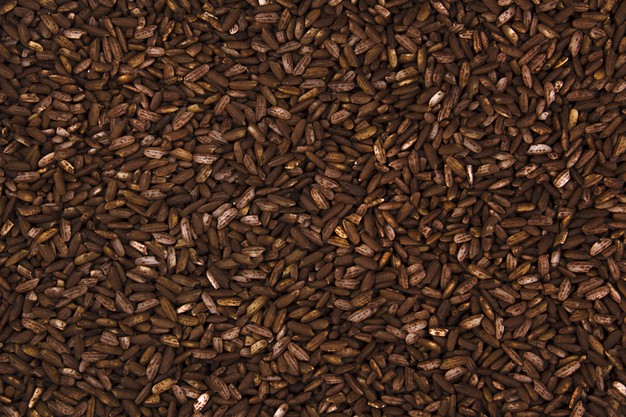Betel leaf is a green coloured heart shaped leaf, belongs to Piperaceae family. It is very popular for its aromatic flavor and extensively used as mouth freshener. It also offers numerous health benefits.
Nutritional profile
- It contains large amount of moistures about 85%
- It contains very less amount of carbohydrate
- It contains crude fibre as well
- It also contains too some extent of protein
- It contains very negligible amount of fat
- It also contains essential oil
- It contains several vitamins like Vitamin A, vitamin C and B vitamins, especially Vitamin B1, B2 and B3
- It also contains various important trace elements, which include potassium, calcium, iron, phosphorus, and iodine
- It contains chlorophyll as well, which is accountable for providing a green colour to it
- It is packed with various important biochemical substances generally termed as phytochemicals, which exert nutraceutical activities and these compounds include chavicol, eugenol, tannin, allylpyrocatechol, β-caryophyllene, diastases and 4-hydroxycatechol
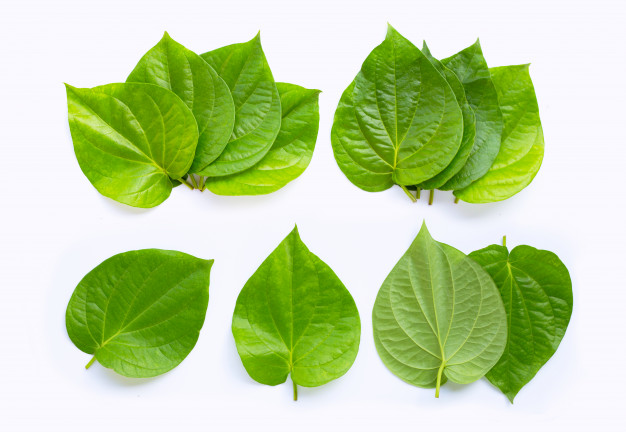
Biological property
Antioxidant activity
- It shows potent antioxidant activity and helps to reduce oxidative stress. Its phytochemical components are considered as the main antioxidant components
- It is associated with decreasing the level of free radicals in body by scavenging them and protects the body from its harmful effects

Anti-carcinogenic activity
- Chewing of betel leaf (alone, without tobacco) is related with reducing the prevalence of cancers as it has strong anti-mutagenic as well as anti-proliferative property
- It helps to suppress the growth of malignant cells as well as tumor cells in body by regulating malignant cell proliferation and also prevents metastasis
Antimicrobial activity
- Phenolic acid, phytochemicals and essential oil components of betel leaf are responsible for exerting antimicrobial activity, which helps to hinder the growth and reproduction of microbes within host
- It has seen that it significantly shows strong antibacterial activity against pseudomonas aeruginosa, Escherichia coli and Staphylococcus aureus
Anti-malarial activity
- Betel leaf has been used for centuries as an effective remedial action for malaria
- Terpenes components of betel leaf is responsible for exerting anti-malarial activity
- Its flavonoid components are also responsible for exerting anti-parasitic activity against various strains of malaria parasite
Anti-asthmatic activity
- It has been extensively used for treating asthma. Its antioxidant as well as anti-inflammatory activities are accountable for preventing this respiratory disorder
- Histamine is considered as one of the most vital cause of asthma as it is related with increasing vasoconstriction of air way due to tightening of smooth muscle. Betel leaf also exerts anti-histaminic activity hence associated with decreasing histamine concentration in body thus reduces the prevalence of vasoconstriction hence improves the symptoms of asthma

Health benefits
Role on preventing diabetes mellitus
- Diabetes mellitus is a metabolic disorder characterized by elevated blood sugar concentration. It should be controlled properly otherwise it may cause severe damage of kidney, eyes and heart
- Proper dietary intake and nutritional support along with medicines play effective role in regulating blood sugar level. Tough anti-diabetic medicines have various side effects but it has seen that consumption of food, which has anti-diabetic effect, does not show any side effects. Betel leaf is considered as a low glycemic food stuff that exerts anti-diabetic effects
- It is very useful for reducing blood sugar concentration as it is associated with increasing insulin sensitivity and its antioxidant effect also helps to reduce the prevalence of diabetes mellitus by inhibiting oxidative stress
- It has seen that consumption of dried betel leaf powder is extremely effective for decreasing the concentration of glucose in blood
Role on regulating cholesterol level
- Eugenol component of betel leaf is responsible for decreasing the concentration of cholesterol in blood thus its consumption is very effective for reducing the harmful consequences of hypercholesterolemia such as cardiovascular diseases, gall stones, hepatic malfunctioning, obesity etc
- It also helps to inhibit the synthesis of cholesterol that ultimately related with decreasing elevated cholesterol level as body utilizes stored cholesterol for its function
- It helps to decrease the concentration of LDL, VLDL and triglyceride in blood as well, which helps to prevent plaque formation within blood vessels by inhibiting fat accumulation thus decreases the prevalence of atherosclerosis and promotes cardiac health
- Whereas it is also related with increasing the level of HDL and helps to maintain a healthy ratio of HDL and LDL in body, which is considered as an indicator of good nutritional status
- Its hypolipidemic activity is closely related with preventing fatty infiltration of liver (fat deposition in liver cell) thus prevents the prevalence fatty liver disease and improves liver functionality

Effect on wound healing
- It plays significant role in accelerating the process of wound healing
- It contains desirable amount of potassium that helps to re-synthesis tissue, which is related with stimulating the process of wound healing
- It is also associated with increasing wound contraction rate that ultimately promotes the healing process
- Its consumption is especially very effective for healing burn wounds

Role on preventing depression
- Depression is known as a mood disorder, which is mainly associated with developing a feeling of sadness. This mental disorder should be corrected properly otherwise it may cause various hazards like it may increase the prevalence of risky behaviors such as drug addiction or alcohol addiction, may increase difficulties in professional field and even in severe condition it may cause death due to suicidal attempt
- There are several therapy available for treating depression like counseling, anti-depressant drug etc but it is better to focus on some herbal remedial action too for inhibiting depression
- Betel leaf has been traditionally used for preventing depression as it has potent stimulatory activity on nervous system especially on central nervous system
- It is also associated with improving mood and thus reduces the prevalence of stress as well as anxiety

Role on oral health
- Chewing of betel leaf is responsible for promoting oral health
- It helps to inhibit the activity and growth of those microbes, which are responsible for oral infections thus its consumption is very beneficial for decreasing the susceptibility of developing dental infections
- It also improves oral hygiene
- It helps to prevent dental carries as well. It helps to inhibit acid production by salivary bacteria, which is related with decreasing the prevalence of dental carries
- It is also used as an effective mouth freshener, which helps to prevent bad mouth odour
Role on digestive health
- Betel leaf is traditionally used for treating gastric ulcer. It has seen that phytochemical components of betel leaf are responsible for exerting anti-ulcerogenic activities by increasing gastric mucous secretion
- It is also associated with decreasing gastric acid production thus helps to improve the symptoms of gastric ulcer
- It plays vital role in protecting the inner layer of the gut from various irritant as well as toxins thus helps to sustain its structure and functionality
- Its antioxidant activity is also responsible for protecting the entire gastrointestinal tract from oxidative damages thus reduces the risk of developing gastrointestinal disorders
- It helps to promote digestion as well. It contains significant amount of magnesium that plays effective role in digestion absorption as well as metabolism of food especially carbohydrate rich food

Risk factors
Over consumption of betel leaf is not a healthy choice as it develops various health complications like vomiting, diarrhoea, stomach upset, gum problems, hypotension, abnormal heart beat and shortness in breath.
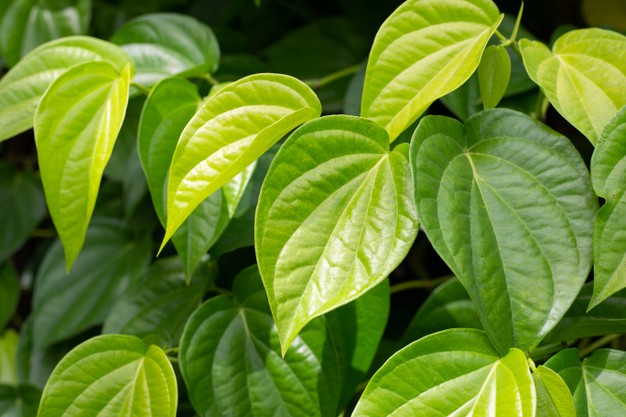
Source:
Guha, P. and Nandi, S., 2019. Essential oil of betel leaf (Piper betle L.): A novel addition to the world food sector. In Essential oil research (pp. 149-196). Springer, Cham.
Gundala, S.R. and Aneja, R., 2014. Piper betel leaf: a reservoir of potential xenohormetic nutraceuticals with cancer-fighting properties. Cancer Prevention Research, 7(5), pp.477-486.
Hossain, M.F., Anwar, M., Akhtar, S. and Numan, S.M., 2017. Uses impact of betel leaf (Piper betle L.) on public health. Science Journal of Public Health, 5(6), p.408.
Kaintura, P., Bhandari, M. and Kumar, R., 2020. Medicinal values of betel leaves and its application in food products: A review.
Madhumita, M., Guha, P. and Nag, A., 2020. Bio‐actives of betel leaf (Piper betle L.): A comprehensive review on extraction, isolation, characterization, and biological activity. Phytotherapy Research, 34(10), pp.2609-2627.
Sripradha, S., 2014. Betel leaf-the green gold. Journal of pharmaceutical sciences and research, 6(1), p.36.
Toprani, R. and Patel, D., 2013. Betel leaf: Revisiting the benefits of an ancient Indian herb. South Asian journal of cancer, 2(3), p.140.
